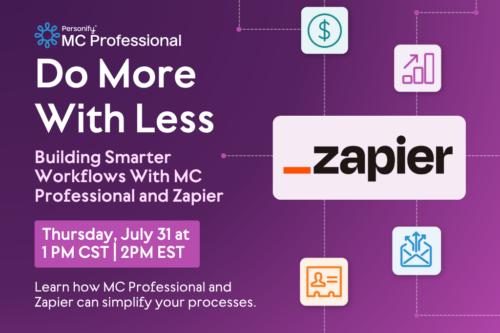Social media is a requirement for any organization, and associations are no exception. Your current and prospective members expect to see you there. A well put-together presence helps build their confidence in you. And, social media puts the good information you want to share right in middle of your audience’s daily scrolling.
It’s not enough to just be there, though. You need to use these channels effectively to make an impact. The rules of good social media for associations are, in most ways, the same as the rules in any other sector. This guide can help you understand what to post, how to post it, and how to get your message in front of the audience you want.
Why Associations Should Be Using Social Media
Sixty-two percent of us use social media, with average users spending nearly two and a half hours a day engaged with it. This built-in audience means you and your association have a handy tool to reach the right audience and get them vital information about your association.
Social media can be used to:
- attract new members.
- remind your audience of member benefits.
- share stories of the good your association does in the community.
Once you have an effective social media presence constructed, you can use it to share any message that will advance the aims of your association.
Which Social Media Platforms Are Best for Associations?
There is no single platform that outperforms all others. Which is best for your association will depend on your goals and your audience. Look at your current membership and determine where they are most likely to spend their virtual time.
Professional associations, for instance, may wish to focus efforts on LinkedIn, where people go for news in their industry. Facebook has an audience that skews female and college-educated, but is widely used by people in a huge range of cohorts, making it a good fit for community associations.
The sorts of content you wish to share is also a factor in the platforms you choose. TikTok is the winner for video content. Facebook and LinkedIn lean toward text. Instagram is good for images and video.
Knowing what you have to say and who you want to reach can help you determine where to concentrate your efforts.
6 Steps to Building a Social Media Strategy for Your Association
Starting from zero can be overwhelming. Take your strategy a step at a time to create a strong platform. Creating a platform, then nurturing your presence there, is a journey you can move along a few steps per day.
1. Define the goals for your social media strategy.
What do you want to accomplish with social media? Are you working to increase membership? Share the news of special benefits and programs? Knowing why you want social media helps you decide how to use it.
For instance, if you want to get current members to be more active in your association, you will want to create content to support that goal. Create snappy graphics highlighting member perks. Make videos where people talk about what membership has meant to them.
2. Determine the platforms you’ll use.
No one can keep up with full engagement on every channel. Even if you use third-party software to post new content and engage with followers, it is easy to neglect platforms when you have too many.
Choose the ones most relevant to your audience. Look at your current membership and determine where people like them go for social media. You can even survey members to see which platforms they are most likely to use.
3. Create a strategic content calendar.
Consistent, quality posting doesn’t happen by chance. Planning in advance is the key to always having fresh content at the right times.
A content calendar is a way to keep everyone on the same page and ensure you are always posting the content that creates the most value. Populate it with events, anniversaries, seasonal notes, and more. Mixing seasonal and evergreen content helps you keep up a consistent stream of valuable content.
4. Develop a social media policy.
Have a policy in place before you need one. This should include banned topics, an association style guide, and rules about who should post and when. This ensures everyone has the same expectations. It can also help avoid going viral for all the wrong reasons.
5. Analyze social media metrics to improve your association’s strategy.
Social media professionals have a wealth of tools at their disposal to see what approaches work best. Check metrics regularly. Who is engaging with your content? What times of day are those people online? What sorts of content work best? Your analytics can give you the answers you need to hone your strategy.
6. Set aside time for interaction.
Remember: social media is social. Successful profiles answer comments and direct messages, repost relevant content, and generally show you are available and engaged.
Many experts suggest a “rule of thirds”. A third of your posting should be dedicated to membership benefits; a third to sharing news relevant to your members; and, a third should be spent interacting with members of your community.
Social Media Content Ideas for Associations
So, you have your profiles set up. Now, what do you post? Here’s a quick primer on what your options are and how to use them to their best advantage.
Text Posts
Text-based posts on platforms like LinkedIn and Facebook are where longform content shines. Create highly readable posts with compelling openers. Statistics, fun facts, and compelling quotes are all ways to draw audiences in.
Have a specific action you want readers to take? Ask them for it. Whether you want them to join today, share your posts, or hit the like and subscribe buttons, a clear call to action can make a difference.
Videos
Most major social media platforms now have video capabilities. Create posts customized for the platform. On TikTok, for instance, the focus is short, vertically oriented clips. LinkedIn and Facebook can feature longer content.
You don’t have to be a professional videographer, but shoot the best quality you can. Clean audio is most important. Good lighting and well-framed shots are also important.
Images
No matter what platforms you choose, you should never underestimate the power of images. Data shows that posts with images have some of the highest engagement rates.
You have a multitude of options when it comes to choosing images. Pictures of people have some of the best results. At your next association event, snap a few photos of people enjoying themselves. Also, don’t forget the power of well-designed, informative graphics. These are highly shareable and can bring new people to your page.
Stories
Stories are short video or photo montages, with most being just a few seconds long. In past incarnations of Facebook and Instagram, these were visible for a day, and then deleted. Now, they appear at the top of a profile when new, but can be viewed later.
The top-of-page nature makes these a great way to mix up your offerings and get out time-sensitive stories.
Hashtags
Use hashtags in a deliberate and meaningful manner. They are a great tool for social listening. By clicking on relevant hashtags, you can see what others are saying about topics important to your association. By including well-chosen ones in your posts, people with like interests can find you.
When using hashtags, choose just a few per post. To keep your posts accessible to all, add hashtags at the end of a post instead of in the middle of sentences. Post using “camel case” where the first letter of each word is capitalized #LikeThis. Together, these make your post easier for those using screen readers.
Ads
Organic reach is a lot of work. In some cases, it is no longer possible to reach your full audience even when posting regularly. Carefully curated ads and other marketing efforts can get your messages in front of the people you want to reach.
The benefit of ads is you can choose exactly who your message goes to. Choose an audience by demographics, browsing history, and more.
Decide your goal before spending money on an ad. Do you want more likes on your page? Are you pushing a membership drive? Having a distinct goal can help you craft an effective ad and help you define your campaign’s success.
Examples of Associations Using Social Media Effectively
Imitation isn’t just the highest form of flattery. Following the examples of successful organizations can help you craft an effective social media presence for your own association.
Take AARP’s robust Facebook presence. The association has multiple highly active Facebook pages, each with a different regional or topical focus. Their AARP Member Benefits page alone has over 500,000 likes. They post multiple times per day, using a combination of images, text, video, and outbound links to bring information to existing and prospective members.
The National Association of Realtors is an exemplar of how to use Instagram’s visually oriented platform effectively. The association, which has over 304,000 followers, mixes inviting photos with clear and informative graphical posts.
The Association for Talent Development uses its LinkedIn presence to share information and recruit new members. They mix eye-catching graphics, arresting statistics, and posts with clear calls to action to engage their audience.
There’s no one right way to use social media. Follow pages of organizations and companies in the same sphere as yours to get good ideas for your own social media presence.
Final Thoughts
Social media for associations is not a sprint. It’s an ongoing effort that must be nurtured over time.
Starting your efforts off right and taking deliberate steps to build your reach take a concerted effort. But, the benefits of a thoughtful presence that is useful to both current and prospective members can help your organization shine.
You don’t have to go it alone. We can help. Explore MemberClicks association management software to learn how to boost renewal rates,
















